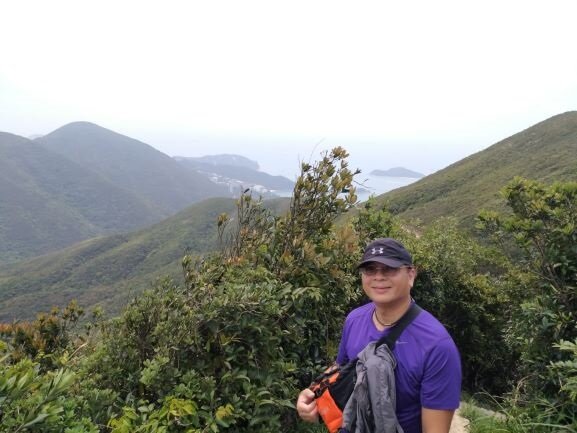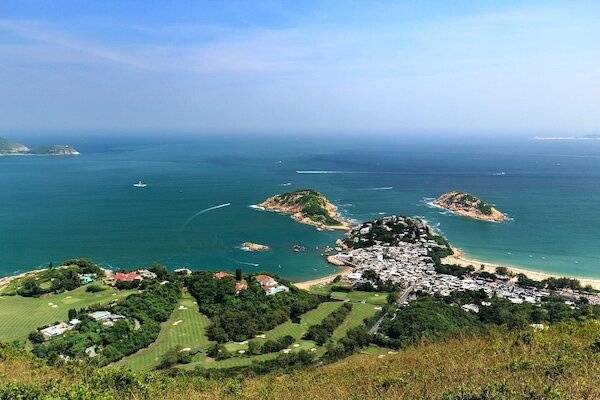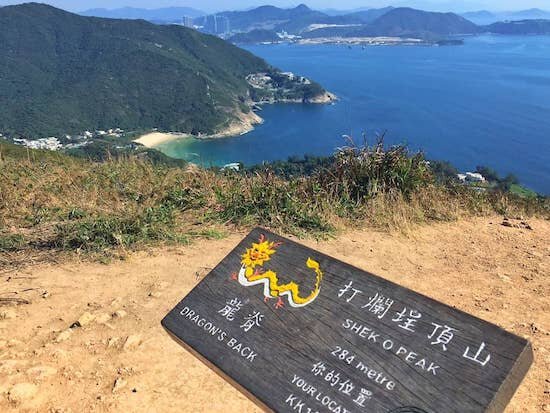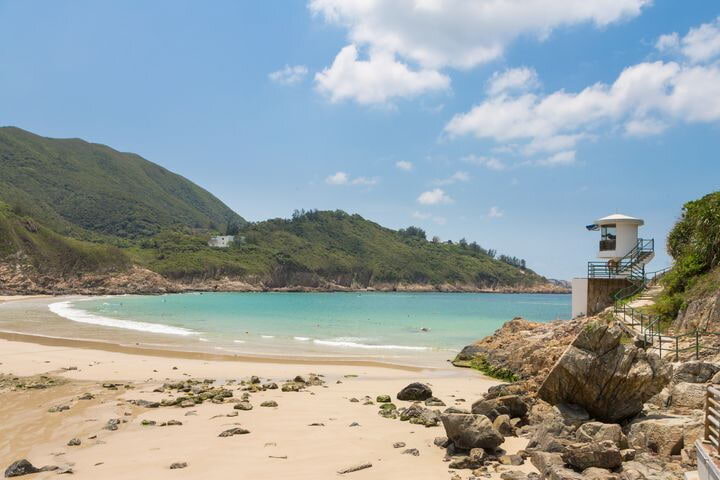Located in the Hong Kong UNESCO Global Geopark, this tiny elongated island is home to geological spectacles created 140 million years ago. It is perfect for visitors to enjoy natural wonders, a fairly short hike and a dip in the sea in one go.
Sharp Island encapsulates Hong Kong's great outdoors at its best with lush greenery, clear waters, beautiful beaches and sweeping views. Photo credit: infinitenation.wordpress.com
Starting point — Hap Mun Bay Beach
Start your day with a short bouncy kaito ride from the Sai Kung Public Pier. Hap Mun Bay, also known as Half Moon Bay, is a picturesque crescent-shaped beach tucked away at the southern tip of Sharp Island with emerald waters. In fact, it consistently tops the water quality ratings among Hong Kong’s beaches. A snack bar, barbecue and picnic sites, showers and lockers are available. Photo credit: unseenhongkong.com
Hak Shan Teng
The hiking route to Kiu Tau starts from the rear of the picnic site. It takes you to the top of the hill — Hak Shan Teng — for a breath-taking panorama of the coastline and the tombolo of Sharp Island. The trees, climbers and thickets along the way are so thick at some spots that it’s like walking through a green tunnel, where you will be greeted by a wide variety of fluttering butterflies. Photo credit: follo3me.com
Kiu Tsui Beach
After hiking for just an hour, Kiu Tsui Beach comes into sight. Partly bouldery and partly sandy, it’s a great spot for scuba-diving, kayaking, swimming and sunbathing. Photo credit: trover.com
Tombolo
If you happen to catch the low tide, witness the emerging promenade that connects the nearby Kiu Tau islet. Stroll along the natural sand levee for a closer look at this interesting coastal landform. Photo credit: unseenhongkong.com
‘Pineapple buns’
Dozens of giant boulders are scattered on the tombolo beaches, looking bizarrely like the local snack ‘pineapple bun’. The quartz monzonite has been weathered and eroded to various degrees to yield irregular cracks. Other typical volcanic rocks found on Sharp Island include volcanic breccia and rhyolite, the former containing angular pyroclasts while the latter’s surface is adorned with lava flow bandings. Photo credit: travelwithkidz.com.au
Photo Tips from Kelvin Yuen
The tombolo is characterised by the many pineapple bun-shaped stones here. See the stone path connecting the Kiu Tau islet appear during low tide. Photo credit: discoverhongkong.com by Kelvin Yuen
Use an ultra-wide-angle lens (e.g. 16 mm) to capture the unique stones in the foreground and highlight the stone path.
*Winner of the National Geographic International Photo Contest 2015, Youth Division
Kiu Tau
Cross the tombolo and follow the trail up Kiu Tau. From the hilltop lookout, you can get a good look at Hap Mun Bay, Port Shelter and Clear Water Bay. Descend to the rocky shore to observe coastal wildlife. At the end of the trail, you will see a beacon guiding ships in Inner Port Shelter. Photo credit: zh.wikipedia.org
Endpoint — Sharp Island Pier
Return to the main island via the tombolo and walk towards the direction of Kiu Tsui Beach. The pier is an elevated platform where you can enjoy one last glimpse of the beautiful scenery before hopping onto the kaito. Photo credit: wanderingsnow.com
Click here for a better resolution of Sharp Island Trail map.
Info:
Area: Sai Kung District
Starting point: Hap Mun Bay Beach
Endpoint: Sharp Island Pier
Average hiking time: About 2 hours
Distance: Approximately 3 km
Replenishing stations: Sai Kung town centre has lots of options for stocking up.
Difficulty: Moderate - Short walk; but mind rugged relief at the tombolo and few stops for replenishment
How to get there:
To the starting point:
From MTR Diamond Hill Exit C2, take bus 92 to Sai Kung Town, then board a kaito at Sai Kung Public Pier to Hap Mun Bay.
Alternatively, from Sha Tin New Town Plaza Bus Terminus take bus number 299X to Sai Kung Town, then board a kaito at Sai Kung Public Pier.
The kaito ride takes around 15 minutes. An adult one-way ticket costs around $20-40. Costs vary between weekends and weekdays, and between peak season (summer) and low season.
From the end point:
Board a kaito at Sharp Island Public Pier to return to Sai Kung Public Pier.
From Sai Kung Town, public transport is available to other destinations.
Sai Kung Ferry Traders Association (enquiry):
+852 9080 5794 / +852 9082 2057


































































